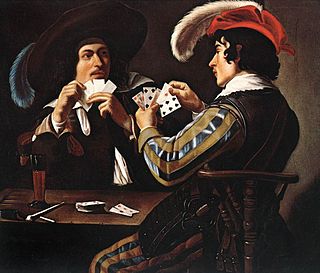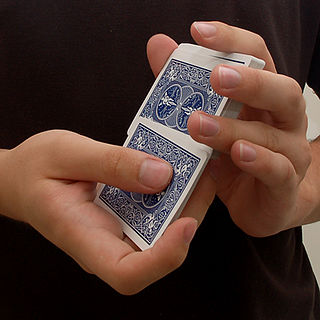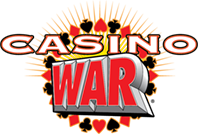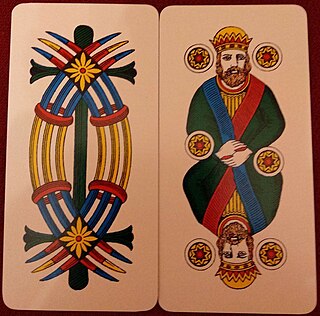
Blackjack is a casino banking game. The most widely played casino banking game in the world, it uses decks of 52 cards and descends from a global family of casino banking games known as Twenty-One. This family of card games also includes the British game of Pontoon, the European game, Vingt-et-Un and the Russian game Ochko. Blackjack players do not compete against each other. The game is a comparing card game where each player competes against the dealer.

A card game is any game using playing cards as the primary device with which the game is played, be they traditional or game-specific.
Five-card draw is a poker variant that is considered the simplest variant of poker, and is the basis for video poker. As a result, it is often the first variant learned by new players. It is commonly played in home games but rarely played in casino and tournament play. The variant is also offered by some online venues, although it is not as popular as other variants such as seven-card stud and Texas hold 'em.

Poker is a family of comparing card games in which players wager over which hand is best according to that specific game's rules. It is played worldwide, however in some places the rules may vary. While the earliest known form of the game was played with just 20 cards, today it is usually played with a standard deck, although in countries where short packs are common, it may be played with 32, 40 or 48 cards. Thus poker games vary in deck configuration, the number of cards in play, the number dealt face up or face down, and the number shared by all players, but all have rules that involve one or more rounds of betting.

Shuffling is a procedure used to randomize a deck of playing cards to provide an element of chance in card games. Shuffling is often followed by a cut, to help ensure that the shuffler has not manipulated the outcome.

Baccarat or baccara is a card game played at casinos. It is a comparing card game played between two hands, the "player" and the "banker". Each baccarat coup has three possible outcomes: "player", "banker", and "tie". There are three popular variants of the game: punto banco, baccarat chemin de fer, and baccarat banque. In punto banco, each player's moves are forced by the cards the player is dealt. In baccarat chemin de fer and baccarat banque, by contrast, both players can make choices. The winning odds are in favour of the bank, with a house edge of at least 1 percent.

Card counting is a blackjack strategy used to determine whether the player or the dealer has an advantage on the next hand. Card counters are advantage players who try to overcome the casino house edge by keeping a running count of high and low valued cards dealt. They generally bet more when they have an advantage and less when the dealer has an advantage. They also change playing decisions based on the composition of the deck.
Spanish 21 is a blackjack variant owned by Masque Publishing Inc., a gaming publishing company based in Colorado. Unlicensed, but equivalent, versions may be called Spanish blackjack. In Australia and Malaysia, an unlicensed version of the game, with no dealer hole card and significant rule differences, is played in casinos under the name "Pontoon". It was first introduced about 1995.
Chinese Blackjack is also known as 21-point, ban-luck (Hokkien), ban-nag (Cantonese), and xì dách (Vietnamese). The game is played in South East Asia and resembles conventional Blackjack. In Malaysia, this variant is known as Kampung (Village) Blackjack to differentiate it from the standard Casino Blackjack, and it grew from the game played in the old days in villages.

Casino War is a proprietary casino table game based on the game of War. It is distributed by Shuffle Master, a division of Scientific Games. The game is one of the most easily understood casino card games.

A dealing shoe or dealer's shoe is a gaming device, mainly used in casinos, to hold multiple decks of playing cards. The shoe allows for more games to be played by reducing the time between shuffles and less chance of dealer cheating. In some games, such as blackjack, using multiple decks of cards can increase the house edge.

Super Fun 21 is a variation of blackjack. The game is played using a standard 52 card deck. Aces can be counted as either a one or eleven depending on which value would best benefit the player's hand. All the face cards in the deck each count as ten. The remaining cards are taken at face value. The player must first place a bet and is then dealt two cards face up. The dealer is dealt two cards as well, but one is face up and one face down. The player then has the option to either "hit", or "stand". The player's hand must beat the dealer's by coming closer to 21 without "busting". A winning hand with a total of 21 is called a blackjack, or natural.
Jerry L. Patterson is an American writer. He authored several gambling books as well as a gambling newspaper column.
Blackjack Switch is a casino gambling game invented by Geoff Hall and patented in 2009. It is based on blackjack, but differs in that two hands, rather than one, are dealt to each playing position, and the player is initially allowed to exchange ("switch") the top two cards between hands. Natural blackjacks are paid 1:1 instead of the standard 3:2, and a dealer hard 22 pushes all player hands except a natural.

Malaysian Pontoon is a card game related to Pontoon and blackjack and, like those games, a descendant of Vingt-Un or Twenty-One. It is played by those in Australia, Malaysia and Singapore, where it is usually just called pontoon. This game is similar to match play 21 or Spanish 21, while original pontoon, played in Britain, holds closer to the traditional Twenty-One rules, but can be quickly distinguished by the use of the terms "twist" and "stick".
In card games, hole carding is the obtaining of knowledge of cards that are supposed to be hidden from view. The term is usually applied to blackjack but can apply to other games with hidden hole cards, like three card poker and Caribbean stud poker. So long as it does not involve the use of a device like a mirror or actions like touching the dealer's cards, in most jurisdictions hole carding is a legal form of advantage gambling. In some games, like stud poker, casinos normally have rules against rubbernecking or having a confederate stand behind an opponent to signal hole cards.

Sette e mezzo is an Italian comparing card game similar to blackjack. In Spanish it is known as Siete y Media. It is traditionally played in Italy during Christmas holidays. The game is also known in English as Seven and a half.

Splitting aces and eights is part of blackjack basic strategy. Rules vary across gambling establishments regarding resplitting, doubling, multiple card draws, and the payout for blackjack, and there are conditional strategic responses that depend upon the number of decks used, the frequency of shuffling and dealer's cards. However, regardless of the various situations, the common strategic wisdom in the blackjack community is to "Always split aces and eights" when dealt either pair as initial cards. This is generally the first rule of any splitting strategy.

The following is a glossary of terms used in the card game blackjack. This is not intended to be a formal dictionary; precise usage details and multiple closely related senses are omitted here in favor of concise treatment of the basics.













